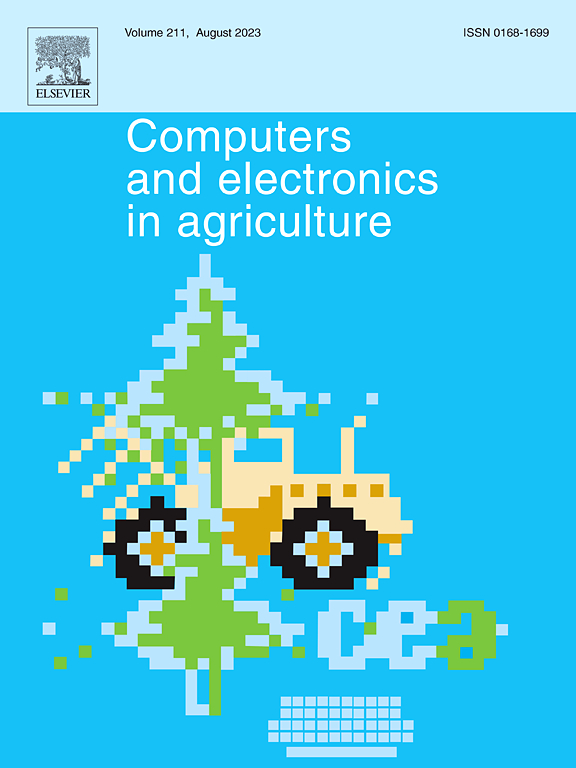Adaptive LiDAR odometry and mapping for autonomous agricultural mobile robots in unmanned farms
IF 7.7
1区 农林科学
Q1 AGRICULTURE, MULTIDISCIPLINARY
引用次数: 0
Abstract
Unmanned and intelligent agricultural systems are crucial for enhancing agricultural efficiency and for helping mitigate the effect of labor shortage. However, unlike urban environments, agricultural fields impose distinct and unique challenges on autonomous robotic systems, such as the unstructured and dynamic nature of the environment, the rough and uneven terrain, and the resulting non-smooth robot motion. To address these challenges, this work introduces an adaptive LiDAR odometry and mapping framework tailored for autonomous agricultural mobile robots operating in complex agricultural environments. The proposed framework consists of a robust LiDAR odometry algorithm based on dense Generalized-ICP scan matching, and an adaptive mapping module that considers motion stability and point cloud consistency for selective map updates. The key design principle of this framework is to prioritize the incremental consistency of the map by rejecting motion-distorted points and sparse dynamic objects, which in turn leads to high accuracy in odometry estimated from scan matching against the map. The effectiveness of the proposed method is validated via extensive evaluation against state-of-the-art methods on field datasets collected in real-world agricultural environments featuring various planting types, terrain types, and robot motion profiles. Results demonstrate that our method can achieve accurate odometry estimation and mapping results consistently and robustly across diverse agricultural settings, whereas other methods are sensitive to abrupt robot motion and accumulated drift in unstructured environments. Further, the computational efficiency of our method is competitive compared with other methods. The source code of the developed method and the associated field dataset are publicly available at https://github.com/UCR-Robotics/AG-LOAM.
无人智能农业系统对于提高农业效率和缓解劳动力短缺至关重要。然而,与城市环境不同,农田给自主机器人系统带来了明显而独特的挑战,例如环境的非结构化和动态性质、崎岖不平的地形以及由此产生的非平稳机器人运动。为了应对这些挑战,本研究为在复杂农业环境中运行的自主农业移动机器人量身定制了一个自适应激光雷达测距和绘图框架。所提出的框架包括基于密集广义 ICP 扫描匹配的鲁棒激光雷达测距算法,以及考虑运动稳定性和点云一致性的自适应地图更新模块。该框架的主要设计原则是通过剔除运动失真点和稀疏动态物体来优先考虑地图的增量一致性,进而通过与地图的扫描匹配来实现高精度的里程测量。通过对在真实世界农业环境中收集的具有各种种植类型、地形类型和机器人运动特征的田间数据集进行广泛评估,对照最先进的方法,验证了所提方法的有效性。结果表明,我们的方法可以在各种农业环境中持续、稳健地实现精确的里程估算和绘图结果,而其他方法则对机器人在非结构化环境中的突然运动和累积漂移非常敏感。此外,与其他方法相比,我们方法的计算效率也很有竞争力。所开发方法的源代码和相关的实地数据集可在 https://github.com/UCR-Robotics/AG-LOAM 网站上公开获取。
本文章由计算机程序翻译,如有差异,请以英文原文为准。
求助全文
约1分钟内获得全文
求助全文
来源期刊

Computers and Electronics in Agriculture
工程技术-计算机:跨学科应用
CiteScore
15.30
自引率
14.50%
发文量
800
审稿时长
62 days
期刊介绍:
Computers and Electronics in Agriculture provides international coverage of advancements in computer hardware, software, electronic instrumentation, and control systems applied to agricultural challenges. Encompassing agronomy, horticulture, forestry, aquaculture, and animal farming, the journal publishes original papers, reviews, and applications notes. It explores the use of computers and electronics in plant or animal agricultural production, covering topics like agricultural soils, water, pests, controlled environments, and waste. The scope extends to on-farm post-harvest operations and relevant technologies, including artificial intelligence, sensors, machine vision, robotics, networking, and simulation modeling. Its companion journal, Smart Agricultural Technology, continues the focus on smart applications in production agriculture.
 求助内容:
求助内容: 应助结果提醒方式:
应助结果提醒方式:


